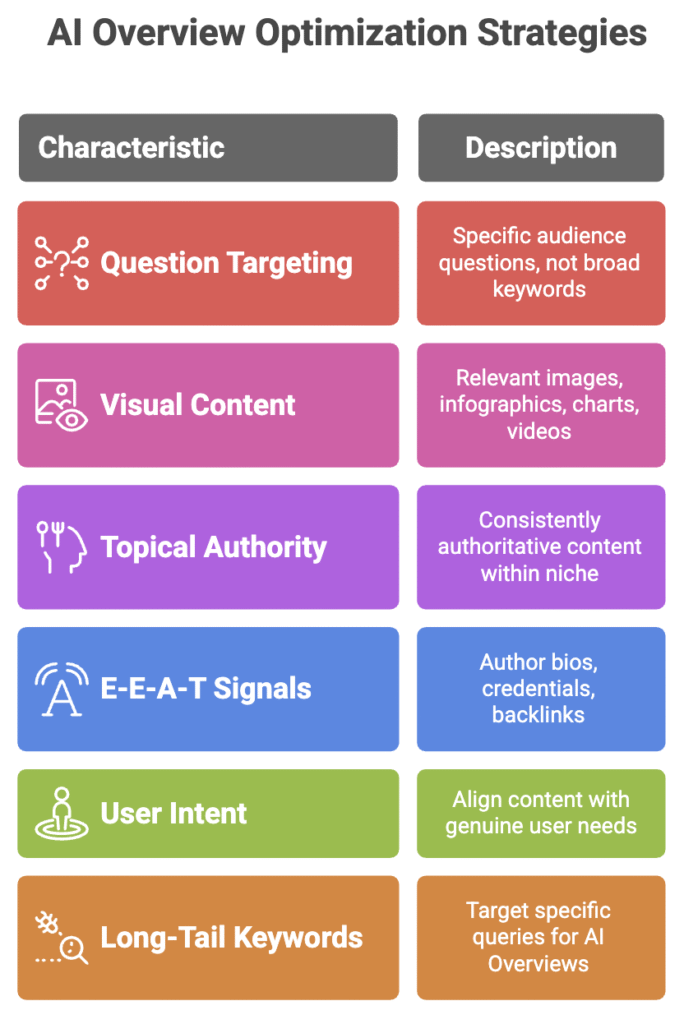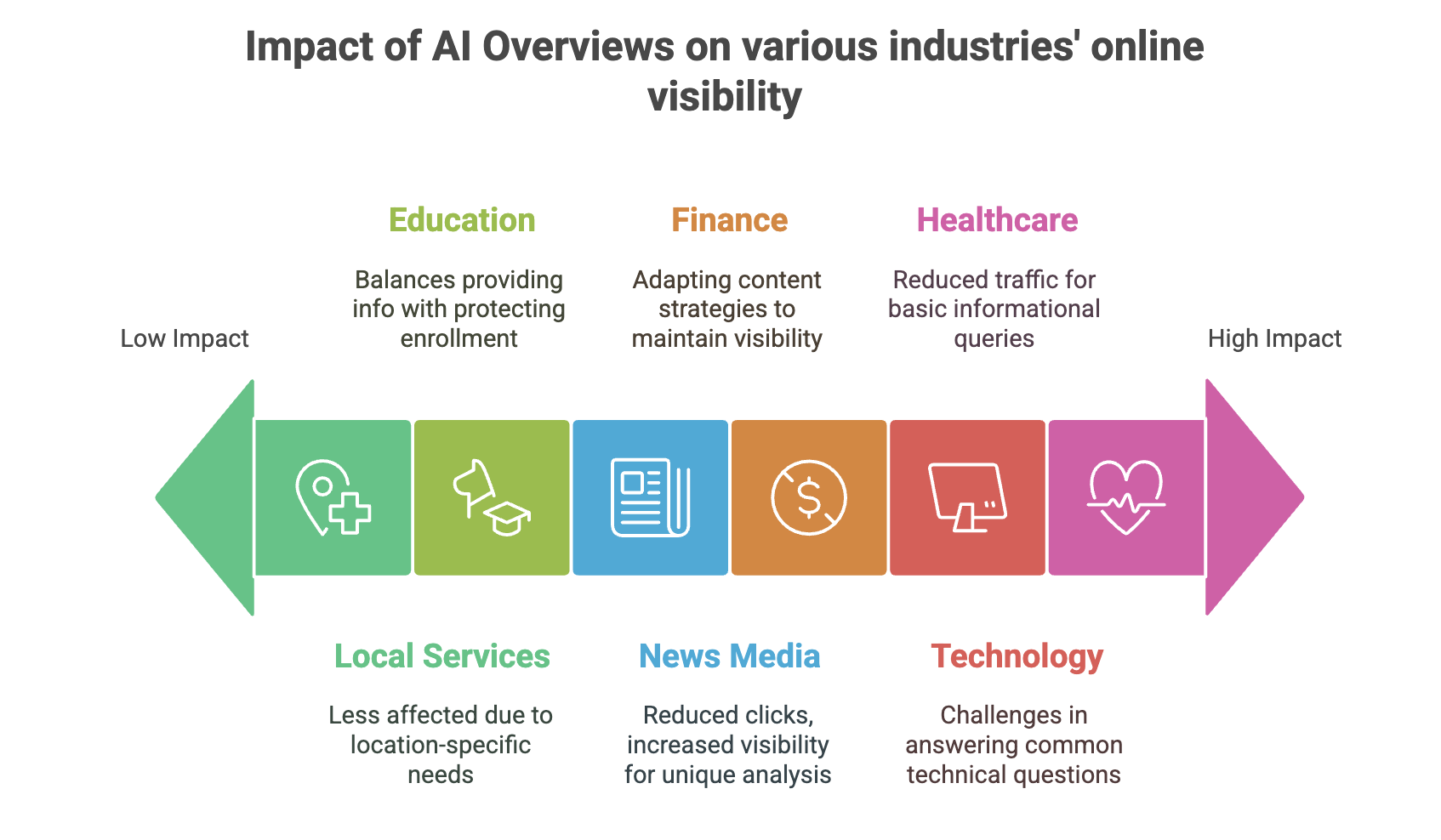Google AI Overviews represent one of the most significant changes to search behavior since the introduction of featured snippets. These AI-generated summaries appear at the top of search results, fundamentally altering how users interact with search engines and creating new challenges and opportunities for businesses, content creators, and SEO professionals.
What Are Google AI Overviews?
Google AI Overviews are AI-generated summaries that appear prominently at the top of search results pages, providing users with comprehensive answers to their queries without requiring them to click through to individual websites. These overviews synthesize information from multiple sources across the web to create cohesive, informative responses that directly address user intent.
Unlike traditional search results that present a list of links, AI Overviews aim to provide complete answers within the search results page itself. They typically include text summaries, relevant images, and citations to source materials, creating a rich, self-contained information experience.
The feature rolled out gradually throughout 2024, initially appearing for complex queries before expanding to cover a broader range of search terms. Google’s AI Overviews leverage the company’s advanced language models to understand context, synthesize information, and present it in a user-friendly format.
How Google AI Overviews Work
Google AI Overviews operate through a sophisticated process that combines natural language processing, machine learning, and web crawling technologies. The system works by analyzing vast amounts of web content to identify authoritative sources, extract relevant information, and synthesize it into coherent summaries.
The process begins when a user enters a search query. Google’s AI systems evaluate the query’s complexity and determine whether an AI Overview would be beneficial. For qualifying queries, the system searches through its index of web pages, identifying multiple sources that contain relevant information.
The AI then analyzes these sources, extracting key facts, concepts, and details while maintaining accuracy and context. It synthesizes this information into a coherent narrative that addresses the user’s specific question or need. The system also identifies and includes relevant images, charts, or other visual elements that enhance understanding.
Citations play a crucial role in AI Overviews, with Google providing links to the original sources used in generating the summary. This transparency helps maintain credibility while providing users with opportunities to explore topics in greater depth.
The ranking and selection of sources for AI Overviews appears to favor content that demonstrates experience, expertise, authoritativeness, and trustworthiness (E-E-A-T). Google’s algorithms prioritize well-established websites, comprehensive content, and sources with strong topical authority when generating these summaries.
Impact on Search Behavior and Zero-Click Searches
The introduction of AI Overviews has significantly accelerated the trend toward zero-click searches, where users obtain their desired information without clicking through to any website. This shift represents a fundamental change in how people consume information online.
Ahrefs’ study suggests that AI Overviews can reduce click-through rates to traditional search results by 20-35% for queries where they appear. Users increasingly rely on the AI-generated summaries as complete answers, particularly for factual queries, how-to questions, and informational searches.
This behavior change affects different types of searches differently. Navigational searches (looking for specific websites) remain largely unaffected, while informational searches see the most significant impact. Commercial and transactional searches fall somewhere in between, with AI Overviews often serving as research tools that influence later purchasing decisions.
The average time spent on search results pages has increased as users read through AI Overviews, but overall session duration across the web may decrease as users find answers more quickly. This efficiency benefit for users creates new challenges for website owners who previously relied on search traffic for visibility and revenue.
User engagement patterns also show increased interaction with visual elements within AI Overviews, including images, charts, and embedded content. This trend emphasizes the importance of multimedia content in modern SEO strategies.
Which Industries are Mostly Impacted by AI Overviews
Several industries face particularly significant challenges from the rise of AI Overviews, primarily those that have traditionally relied heavily on informational search traffic.
- Healthcare and Medical Information stands as one of the most affected sectors. AI Overviews frequently appear for health-related queries, providing quick answers about symptoms, treatments, and medical procedures. While Google maintains strict quality standards for health information, medical websites may see reduced traffic for basic informational queries.
- Finance and Investment industries experience similar impacts, with AI Overviews addressing questions about financial concepts, investment strategies, and market information. Financial education websites and advisory services may need to adapt their content strategies to remain visible.
- Technology and Software companies face challenges as AI Overviews provide quick answers to technical questions, troubleshooting guides, and product comparisons. This trend particularly affects companies that built their online presence around solving common technical problems.
- Education and E-learning platforms see mixed effects. While AI Overviews may reduce traffic for basic educational queries, they can also drive interest in more comprehensive learning resources. Educational institutions must balance providing helpful information with protecting their traffic and enrollment goals.
- News and Media Organizations experience complex impacts. While AI Overviews may reduce clicks for breaking news summaries, they can increase visibility for authoritative sources that provide in-depth analysis and unique perspectives.
- Local Service Businesses generally see less impact from AI Overviews, as these searches often require location-specific information and direct contact with service providers. However, businesses providing general advice or information may need to adjust their strategies.
How AI Overviews Implicate your SEO Strategy
The rise of AI Overviews necessitates a fundamental shift in SEO thinking, moving beyond traditional click-based metrics toward visibility and authority within AI-generated content. SEO professionals must now optimize AI systems (GEO) that synthesize and present information.
Traditional keyword optimization remains important but must be supplemented with topic coverage and semantic richness. Content that thoroughly addresses related subtopics and provides complete answers to user questions has a better chance of being featured in AI Overviews.
E-E-A-T (Experience, Expertise, Authoritativeness, Trustworthiness) becomes even more critical as Google’s AI systems prioritize content from recognized authorities in their respective fields. Building topical authority through consistent, high-quality content creation in specific niches becomes essential for AI Overview inclusion.
Content structure and formatting take on new importance, with AI systems favoring well-organized information that can be easily parsed and synthesized. Clear headings, bullet points, and logical information hierarchy help AI systems understand and extract relevant content.
The relationship between AI Overviews and featured snippets creates new optimization opportunities. Content optimized for featured snippets often appears in AI Overviews, making snippet optimization a dual-purpose strategy.
How to Optimize for AI Overviews
Successfully optimizing for AI Overviews requires a multi-faceted approach that combines traditional SEO principles with new strategies designed specifically for AI consumption.
- Focus on Comprehensive Topic Coverage: Create content that thoroughly addresses topics from multiple angles rather than targeting individual keywords. AI systems favor sources that provide complete information, so develop pillar pages and topic clusters that demonstrate deep expertise in your subject area.
- Implement Structured Data Markup: Use schema markup to help AI systems understand your content’s context and meaning. Implement appropriate structured data for articles, FAQs, how-to guides, and other content types to increase the likelihood of inclusion in AI Overviews.
- Optimize for Question-Based Queries: Research and target the specific questions your audience asks rather than just broad keywords. Use tools like Answer the Public, People Also Ask boxes, and customer service inquiries to identify question patterns that AI Overviews commonly address.
- Create High-Quality Visual Content: Include relevant images, infographics, charts, and videos that support your written content. AI Overviews frequently incorporate visual elements, and multimedia content can increase your chances of inclusion while providing additional value to users.
- Build Topical Authority: Consistently publish authoritative content within your niche to establish expertise. Create content calendars that systematically cover all aspects of your topic area, demonstrating comprehensive knowledge that AI systems can reference.
- Optimize Content Structure: Organize information with clear headings, subheadings, and logical flow. Use bullet points, numbered lists, and short paragraphs to make content easily scannable by both users and AI systems. Include summary sections that could serve as potential overview content.
- Strengthen E-E-A-T Signals: Enhance your website’s E-E-A-T through author bios, credentials, certifications, and authoritative backlinks. Create comprehensive “About” pages and author profiles that establish credibility in your field.
- Monitor and Analyze Performance: Track your appearance in AI Overviews using tools that can identify when your content is featured. Monitor changes in organic traffic patterns and adjust strategies based on performance data.
- Develop Content Partnerships: Collaborate with other authoritative sources in your industry to create comprehensive resources that AI systems are more likely to reference. Guest posting and content collaboration can increase your visibility within AI Overviews.
- Focus on User Intent: Align content creation with genuine user needs rather than search engine manipulation. AI systems increasingly prioritize content that truly serves user intent, making user-focused content creation more important than ever.
- Maintain Content Freshness: Regularly update existing content to ensure accuracy and relevance. AI systems favor current information, so implement content maintenance schedules that keep your resources up-to-date.
- Leverage Long-Tail Keywords: Target specific, long-tail queries that are likely to trigger AI Overviews. These queries often have clear intent and allow for comprehensive answers that AI systems can effectively synthesize.

Future Outlook
AI Overviews will likely continue as Google refines its AI capabilities and user adoption grows. Expect to see more sophisticated integration of multimedia content, improved personalization based on user history and preferences, and expansion into new query types and industries.
The relationship between AI Overviews and traditional search results will continue to evolve, potentially creating new hybrid formats that combine AI-generated summaries with traditional link-based results. SEO professionals must stay adaptable and continue refining their strategies as the landscape changes.
The success of businesses in this new environment will depend on their ability to provide genuine value to users while building the authority and trust that AI systems recognize and reward. Those who focus on user needs and authoritative content creation will be best positioned to thrive in the AI Overview era.
